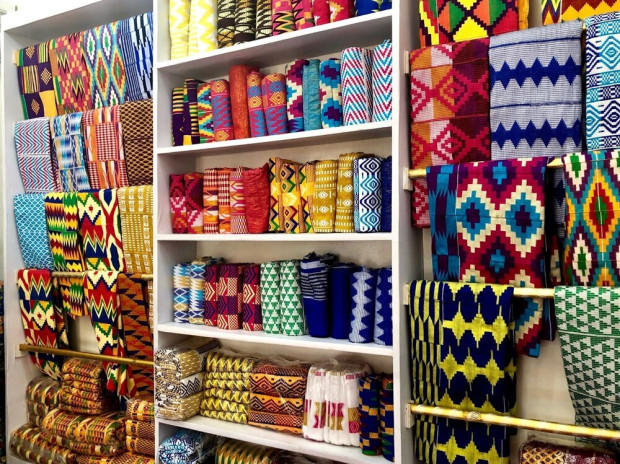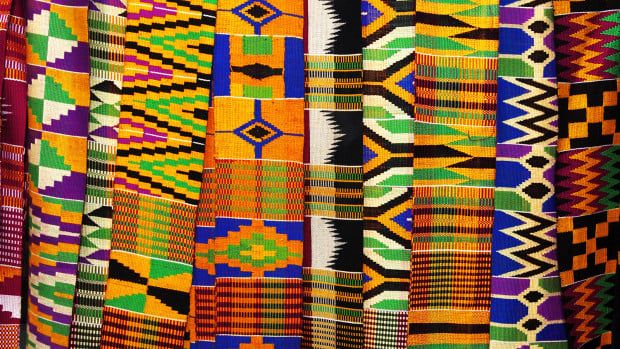Stories and facts
Kente cloth, a cherished Ghanaian textile composed of hand-woven silk and cotton strips, holds deep historical and cultural significance. Originating from the Ewe and Akan people, it was initially worn as royal attire. Today, it is donned widely across Ghana for special occasions and is in high demand, with master weavers leading renowned kente brands. Beyond Ghana, the Ewe and Akan people in parts of Togo and Ivory Coast also embrace this tradition.
The word "Kente" is derived from "kenten," meaning "basket" in the Akan dialect, referring to its basket-like pattern. According to Ashanti folklore, weavers sought to replicate the intricate patterns of Anansi the spider. Archaeological evidence traces handloom weaving in Southern Ghana back to the 14th–18th centuries, with Bonwire emerging as a significant hub for Kente production.

Throughout the 17th and 18th centuries, Kente weaving flourished, especially during the reigns of notable Ashanti leaders. By the late 18th and early 19th centuries, Kente made from silk reached its peak in Ashanti, with intricate designs and vibrant colors. The term "Kente" might have been attributed by Fante traders to Ashanti fabrics.
The Ewe version of Kente features double-woven bands and has its roots in the 16th century migration from Benin Republic and Western Nigeria. Weaving centers like Keta became prominent among the Ewe migrants settled in Southern Ghana.
Kente production encompasses authentic hand-woven cloth, prints by brands like Vlisco and Akosombo Textile Ltd., and mass-produced patterns, notably from China. Authentic Kente cloth, produced in towns like Bonwire and Sakora Wonoo, involves intricate craftsmanship on wooden looms. Weaving, traditionally a male practice, requires apprenticeship under a master weaver.

Kente patterns, numbering in the hundreds, vary in complexity and carry symbolic meanings. The choice of Kente cloth often reflects its name, colors, and patterns, with names derived from proverbs, historical events, and cultural symbols. Each color in Kente holds symbolic significance, conveying messages ranging from royalty and spirituality to fertility and purity.
In contemporary contexts, Kente has stirred controversy, notably when worn by Democratic Party leaders in the United States in 2020 as a show of solidarity against systemic racism. The usage of Kente patterns by fashion brands like Louis Vuitton has also sparked debates on cultural appropriation and ownership of cultural heritage.
Kente cloth encompasses various types, each carrying unique cultural significance within Ghanaian society:
Adweneasa: Known for its parallel lines, signifying providence and longevity.
Fathia Fata Nkrumah: Recognized by its intricate geometric patterns and vibrant colors, paying tribute to Ghana's first president, Kwame Nkrumah.
Owia: Embraced for its simplicity, characterized by narrow stripes ideal for solemn occasions.
Nsaa: Embellished with chain motifs, symbolizing strength and unity among communities.
Obaakofoo Mmu Man: Notable for its lively colors and elaborate designs, representing principles of democracy and good governance.
Bese Saka: Featuring cocoa pod motifs, reflecting themes of wealth, productivity, and agricultural prosperity.
Nyankonton: Displaying rainbow-colored patterns, conveying messages of hope, promise, and good fortune.
Akyempim: Distinguished by its zigzag patterns, associated with bravery and valor.
These variations are just a glimpse into the rich diversity of Kente cloth, each holding profound cultural and social significance in Ghana. They are frequently worn during significant ceremonies and celebrations, symbolizing tradition and heritage.
Despite controversies, Kente remains a cherished symbol of Ghanaian culture, embodying centuries of tradition, craftsmanship, and symbolism.











